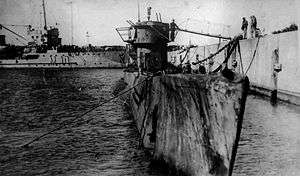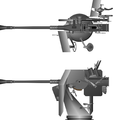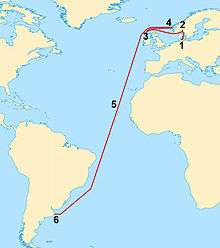German submarine U-977
 U-977 moored at Mar del Plata naval base | |
| History | |
|---|---|
| Name: | U-977 |
| Ordered: | 5 June 1941 |
| Builder: | Blohm & Voss, Hamburg |
| Yard number: | 177 |
| Laid down: | 24 July 1942 |
| Launched: | 31 March 1943 |
| Commissioned: | 6 May 1943 |
| Captured: | Surrendered to Argentine Navy 17 August 1945 at Mar del Plata, Argentina |
| Fate: | Sunk by torpedo from USS Atule during torpedo trials, 13 November 1946 |
| General characteristics | |
| Class and type: | Type VIIC U-boat |
| Displacement: |
|
| Length: |
|
| Beam: |
|
| Draught: | 4.74 m (15.6 ft) |
| Propulsion: |
|
| Speed: |
|
| Range: |
|
| Test depth: | Calculated crush depth: 220 m (720 ft) |
| Complement: | 4 officers, 40–56 enlisted |
| Armament: |
|
German submarine U-977 was a World War II Type VIIC U-boat of Nazi Germany's Kriegsmarine which escaped to Argentina after Germany's surrender. The submarine's voyage to Argentina led to many legends, apocryphal stories and conspiracy theories that together with U-530 it had transported escaping Nazi leaders (including Hitler himself) and/or Nazi gold to South America, that it had made a 66-day passage without surfacing, that it had made a secret voyage to Antarctica, or even that it would be involved in the sinking of Brazilian cruiser Bahia as the last act of the Battle of the Atlantic.[1][2]
Design
German Type VIIC submarines were preceded by the shorter Type VIIB submarines. U-977 had a displacement of 769 tonnes (757 long tons) when at the surface and 871 tonnes (857 long tons) while submerged.[3] She had a total length of 67.10 m (220 ft 2 in), a pressure hull length of 50.50 m (165 ft 8 in), a beam of 6.20 m (20 ft 4 in), a height of 9.60 m (31 ft 6 in), and a draught of 4.74 m (15 ft 7 in). The submarine was powered by two Germaniawerft F46 four-stroke, six-cylinder supercharged diesel engines producing a total of 2,800 to 3,200 metric horsepower (2,060 to 2,350 kW; 2,760 to 3,160 shp) for use while surfaced, two Brown, Boveri & Cie GG UB 720/8 double-acting electric motors producing a total of 750 metric horsepower (550 kW; 740 shp) for use while submerged. She had two shafts and two 1.23 m (4 ft) propellers. The boat was capable of operating at depths of up to 230 metres (750 ft).[3]
The submarine had a maximum surface speed of 17.7 knots (32.8 km/h; 20.4 mph) and a maximum submerged speed of 7.6 knots (14.1 km/h; 8.7 mph).[3] When submerged, the boat could operate for 80 nautical miles (150 km; 92 mi) at 4 knots (7.4 km/h; 4.6 mph); when surfaced, she could travel 8,500 nautical miles (15,700 km; 9,800 mi) at 10 knots (19 km/h; 12 mph). U-977 was fitted with five 53.3 cm (21 in) torpedo tubes (four fitted at the bow and one at the stern), fourteen torpedoes, one 8.8 cm (3.46 in) SK C/35 naval gun, 220 rounds, and an anti-aircraft gun. The boat had a complement of between forty-four and sixty men.[3]
FLAK weaponry
U-977 was mounted with a single 3.7 cm Flakzwilling M43U gun on the rare LM 43U mount. The LM 43U mount was the final design of mount used on U-boats and is only known to be installed on U-boats (U-249, U-826, U-1023, U-1171, U-1305 and U-1306). The 3.7 cm Flak M42U was the marine version of the 3.7 cm Flak used by the Kriegsmarine on Type VII and Type IX U-boats.
 The single 3.7 cm Flak M42U gun on the LM 43U mount.
The single 3.7 cm Flak M42U gun on the LM 43U mount.
Service history

U-977 was launched in March 1943. She was used in training and made no war patrols during her first two years of service. On 2 May 1945 she was sent on her first war patrol, sailing from Kristiansand, Norway, commanded by Oberleutnant zur See Heinz Schäffer (1921–1979). Schäffer's orders were to enter the British port of Southampton and sink any shipping there. This would have been a very dangerous assignment for a Type VII boat. When Admiral Dönitz ordered all attack submarines to stand down on 5 May 1945, U-977 was outbound north of Scotland.
Voyage to Argentina
Oblt.z.S. Schäffer decided to sail to Argentina rather than surrender. During later interrogation, Schäffer said his main reason was a German propaganda broadcast by Goebbels, which claimed that the Allies' Morgenthau Plan would turn Germany into a "goat pasture” and that all German men would be "enslaved and sterilized". Other factors were the poor conditions and long delay in being repatriated suffered by German POWs at the end of World War I (see Forced labor of Germans after World War II), and the hope of better living conditions in Argentina, which had a large German community.
Schäffer offered the married crewmen the option of going ashore in Europe. 16 chose to do so and were landed from dinghies on Holsnøy Island near Bergen on 10 May .
U-977 then sailed to Argentina. Schäffer's version of the voyage states that from 10 May to 14 July 1945 she made a continuous submerged Schnorchel passage, "at 66 days the second longest in the war (after U-978's 68 days)". A conflicting account from the U.S. Navy (USN) report of 19 September 1945[4] contradicts Schäffer's version.
The US Navy Report on the U-977 crew interrogations was compiled within a month of the boat's surrender. It makes no mention of a 66-day voyage always submerged, a striking omission since the voyage must have been fresh in the minds of the German crew. They told the American interrogators that U-977 "made for the Iceland Passage on course 300° (that is, a little North by West) diving once on sighting a plane and once on sighting a ship: "she was also D/F'd many times late in May". (This can also mean traversing in Schnorchel depth and then diving on contact; possible translation errors during interrogations and interrogators failing to ask clarifying questions.)
According to the Navy report, the submarine stopped in the Cape Verde Islands for a short break, then completed the trip traveling on the surface using one engine. Crossing the equator on 23 July, she arrived in Mar del Plata, Argentina on 17 August after 99 days at sea from Bergen and a voyage of 7,644 nmi (14,157 km; 8,797 mi). Schäffer maintained that he crossed the Equator on 23 or 24 July 1945, on this both the US Navy and Schäffer agree. Comparing the USN report with Schäffer's account, the impression is of two separate voyages from Norway meeting up at the Equator on 23 July 1945.
The Schäffer version of the trip said that after stopped in Cape Verde for a short break, they completed the rest of the trip alternating passages in the surface, partly dipped, arriving in Mar del Plata, Argentina, on August 17, after 99 days at sea from Bergen on a journey of 7,644 nautical miles (14,157 km; 8,797 mi).[5]
After surrendering to the Argentine authorities, as had happened to the crew of U-530, they were extradited to the US where responded to the charge of having torpedoed the cruiser Bahia, and then to the UK, where faced accusations that they had landed Nazi leaders in Argentina, before surrendering. Schaeffer was released in 1947. U-977 like U-530 was seized by the US Navy, and sunk during naval firing exercises, in its case in 1946, when it was used as a target.[6]
Schäffer later wrote a book: U-977 – 66 Tage unter Wasser ("U-977 – 66 Days Under Water"), the first postwar memoir by a former U-boat officer. It was published in 1952, and was translated into English under the title U-boat 977.
In the arts
—Preceding undated comment added an unspecified datestamp. Documentary film U-977 - 66 DAYS UNDER WATER directed by Nadine Poulain, Schäffer's granddaughter, currently in the final stages of production.
See also
References
- ↑ Salinas & De Nápoli , 2002.
- ↑ Paterson, 2009. Pages 27 to 33.
- 1 2 3 4 Gröner 1991, pp. 43-46.
- ↑ Office of Naval Intelligence (19 September 1945). "Report on the Interrogation of Prisoners from U-977 (File Op-16-2)". U.S. Navy. Retrieved 21 August 2009.
- ↑ Paterson, 2009. Pages 27 to 33.
- ↑ Kittel & Graf, 2015. p.93.
Bibliography
- Busch, Rainer; Röll, Hans-Joachim (1999). German U-boat commanders of World War II : a biographical dictionary. Translated by Brooks, Geoffrey. London, Annapolis, Md: Greenhill Books, Naval Institute Press. ISBN 1-55750-186-6.
- Busch, Rainer; Röll, Hans-Joachim (1999). Deutsche U-Boot-Verluste von September 1939 bis Mai 1945 [German U-boat losses from September 1939 to May 1945]. Der U-Boot-Krieg (in German). IV. Hamburg, Berlin, Bonn: Mittler. ISBN 3-8132-0514-2.
- Gröner, Erich; Jung, Dieter; Maass, Martin (1991). U-boats and Mine Warfare Vessels. German Warships 1815–1945. 2. Translated by Thomas, Keith; Magowan, Rachel. London: Conway Maritime Press. ISBN 0-85177-593-4.
- Juan Salinas & Carlos De Nápoli (2002) Ultramar Sur: la última operación secreta del Tercer Reich ("South Overseas: the last secret operation of Third Reich") (Spanish) Grupo Editorial Norma ISBN 9789875450752
- Kittel & Graf (2015) The History of U-Boot Edizione R.E.I. ISBN 9782372971768
- Paterson, Lawrence (2009) Black Flag: The Surrender of Germany's U-Boat Forces on Land and at Sea Seaforth Publishing ISBN 9781848320376
- Schäffer, Heinz (2006). El Secreto del U-977. Buenos Aires: Editorial Hisma. ISBN 987-22996-0-9.
- Schäffer, Heinz, Leonce Peillard Der U-Boot-Krieg 1999 ISBN 3-453-14825-8 (In German)
- Schäffer, Heinz, U-Boat 977: The U-Boat That Escaped to Argentina 2005 ISBN 1-84145-027-8 (First published in Germany in 1952 as U-977 – 66 Tage unter Wasser)
External links
- Time Magazine 23 Feb. 1953 Book review "Go In & Sink"
- Helgason, Guðmundur. "The Type VIIC boat U-977". German U-boats of WWII - uboat.net. Retrieved 29 December 2014.
- Hofmann, Markus. "U 977". Deutsche U-Boote 1935-1945 - u-boot-archiv.de (in German). Retrieved 29 December 2014.
